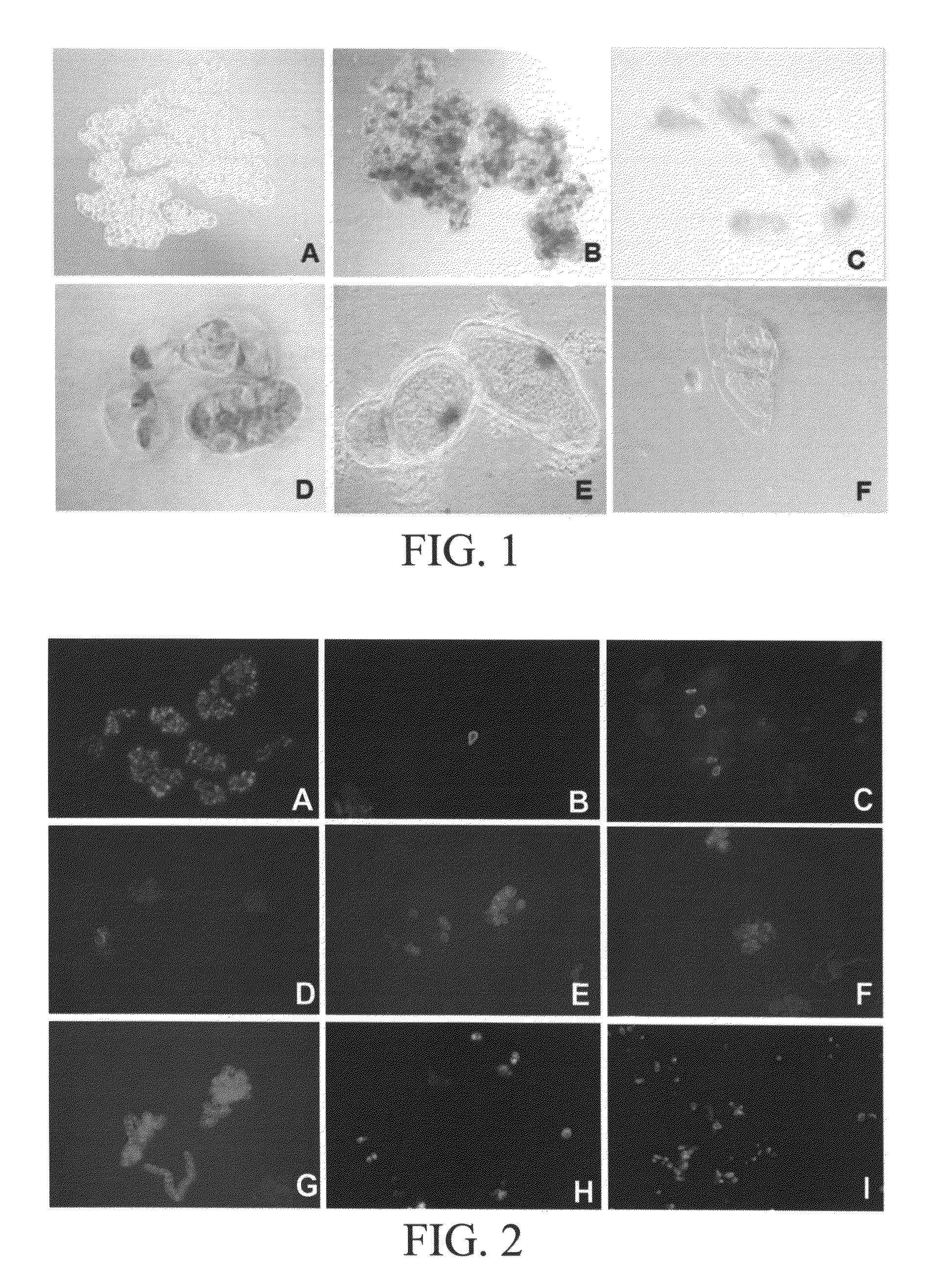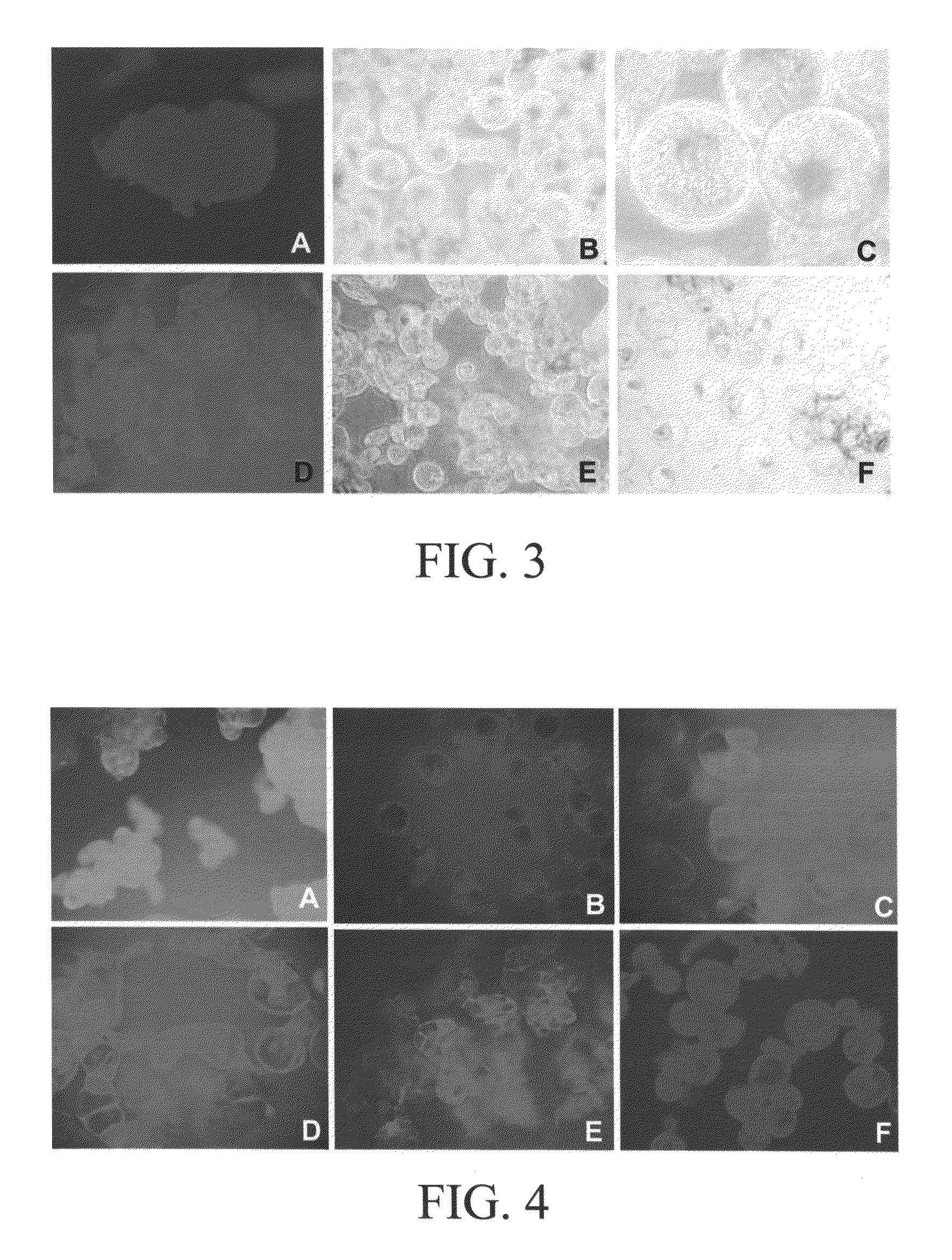In vitro methods for the induction and maintenance of plant cell lines as single suspension cells with intact cell walls, and transformation thereof
a plant cell and in vitro technology, applied in plant cells, biochemistry apparatus and processes, fermentation, etc., can solve the problems of difficult for protoplasts to regenerate their normal walls, high heterogeneity of transgenic lines developed from such cell types, and inability to maintain the integrity of the cell walls
- Summary
- Abstract
- Description
- Claims
- Application Information
AI Technical Summary
Benefits of technology
Problems solved by technology
Method used
Image
Examples
example 1
Materials and Methods
[0075]BY2 suspension-cultured cells were obtained from Japan tobacco and maintained in LSBY2 medium in a 7 day cycle. Jimsonweed suspension and Pettite Havana tobacco suspensions were initiated from callus initiated at DAS and Xanthi suspensions were procured as a sample from Professor Jack Widholm from UTUC, IL. JT-NT1 suspension cells, obtained from Washington University that are maintained in NT1B medium in 7 day cycle were used only for the pectin degradation enzyme study to separate the cells into single cells. The cells were cultured in shake flasks at 25-28° C. in dark on orbital shakers at 150 rpm. Colchicine was obtained from Fluka, DAS-PMTI-1 (Martin et. al, 2001; Smith et al., 2001), obtained from DAS CRS, and the pectin degrading enzymes (pectolyase Y and pectinase) were from Sigma. Stock concentrations of both the tubulin polymerization inhibitors used in this investigation were dissolved in DMSO to prepare a 0.5 M stock solution. The concentration ...
example 2
Microscopic Observations
[0076]Cell expansion and separation were observed by light microscopy (with Nomarski and dark field optics). Spherical cells and single cells were counted by using a hemacytometer to determine the degree of cell expansion and separation, respectively. Cell numbers in aggregates were determined by treating with 5% (wt / vol) chromium trioxide for 16 hr and counting cells (Henshaw et. al, 1966). Cell viability was determined by staining cells (Yokoyama et.al, 1997) with fluorescein diacetate (FDA) and propidium iodide (PI) using a fluorescent microscope (Zeiss Photomicroscope). In order to determine the presence of the cell wall in this single cell cultures optical brightener was used. Calcafluor obtained from Sigma, which is a specific fluorescent dye for cellulose is used in this study, and the cellulose-Calcafluor complexing was observed by fluorescence microscopy (Zeiss Photomicroscope). Calcofluor (Sigma Chemical Co., St. Louis, Mo.) was prepared as a 0.1% (...
example 3
Results of Continuous Pectinase and Pectolyase Treatments in the Medium
[0077]Petite Havana, BY2 and NT1 tobacco suspensions were used to investigate the effect of pectin degrading enzymes, pectinase and pectolyase at different concentrations. JT-NT1 suspensions did respond to pectinase treatments better and BY2 suspension responded to pectolyase enzyme treatments better than the other enzyme counterpart. However, there was cell mortality as visualized by the vital stains and the inhibitory growth of the cell types. The inoculum volume of cells at the sub culture stage was increased up to 12 times to have reasonable yield of the single cells. PH and the BY2 cells could be cultured for at least 7 days in culture with pectolyase. Continuous culture of these cells in low concentration pectolyase enzyme (3 active units) appeared to be detrimental. The cells at 6th day of culture yielded high single cells when the volume of inoculum was 6 ml (starter inoculum volume at stationary phase) a...
PUM
| Property | Measurement | Unit |
|---|---|---|
| diameter | aaaaa | aaaaa |
| volume | aaaaa | aaaaa |
| volume | aaaaa | aaaaa |
Abstract
Description
Claims
Application Information
 Login to View More
Login to View More - R&D
- Intellectual Property
- Life Sciences
- Materials
- Tech Scout
- Unparalleled Data Quality
- Higher Quality Content
- 60% Fewer Hallucinations
Browse by: Latest US Patents, China's latest patents, Technical Efficacy Thesaurus, Application Domain, Technology Topic, Popular Technical Reports.
© 2025 PatSnap. All rights reserved.Legal|Privacy policy|Modern Slavery Act Transparency Statement|Sitemap|About US| Contact US: help@patsnap.com



